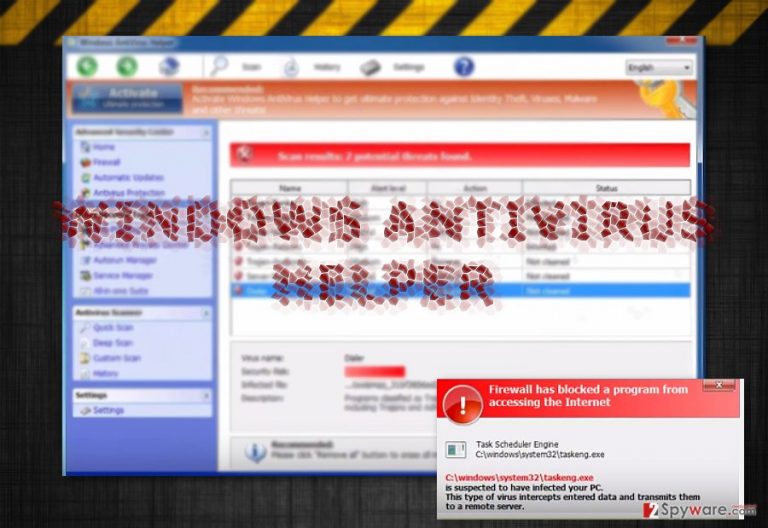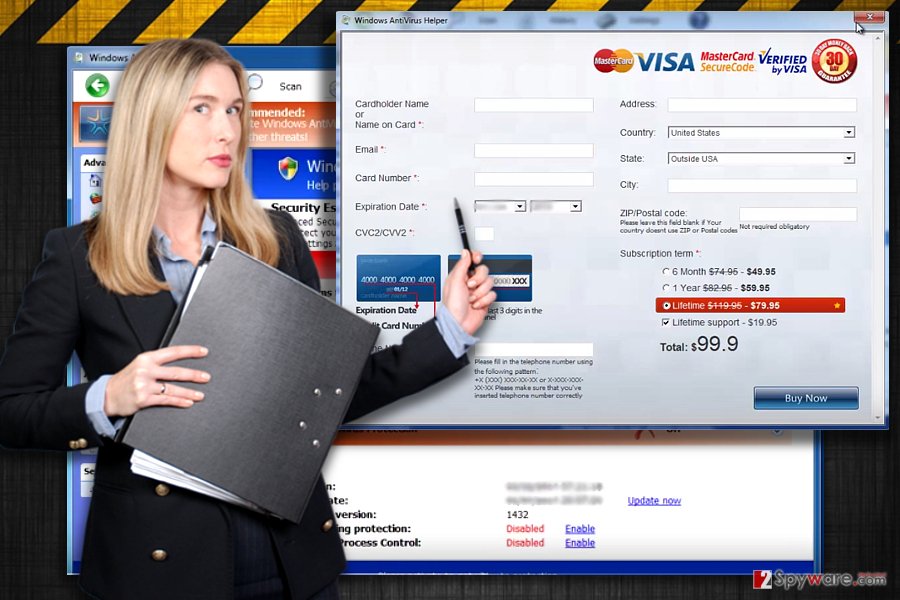Windows AntiVirus Helper (Free Instructions) - Free Guide
Windows AntiVirus Helper Removal Guide
What is Windows AntiVirus Helper?
Windows Antivirus Helper wants to wheedle out money for eliminating “system threats”

Windows AntiVirus Helper functions as a rogue cyber security tool[1] associated with Rogue.FakeVines family of malicious apps. It is presented as a utility which locates and eliminates all threats present on the system.
This specific program relies only on misleading techniques when seeking this aim. In order to trick people into opening their wallets, Windows AntiVirus Helper counterfeits notifications about a heavily infected operating system. Thus, alarmed by such fake messages, users may rush to purchase the full version of the software.
However, there is a catch: before you do so, you are asked to sign up and enter your credit card details.[2] Eventually, the services of this rogue antivirus tool will cost you $100.
You will also see the transaction and Windows Antivirus Helper phone number. The latter might be promoted in the app, though it may display different numbers.
In contrast to other rogue security applications, this software will directly interfere with the legitimate Windows applications and processes. It may even prevent Google Chrome, Internet Explorer, Mozilla Firefox or another browser from running. Naturally, it may also meddle with the launch process of genuine anti-virus utility.[3] Due to such activity, we highly recommend performing Windows Antivirus Helper removal. FortectIntego or Malwarebytes will help you get rid of this application.
Cramming users with counterfeited alerts
One of the key most annoying features of this malware is that it starts right after you log in to Windows. The scan only takes a couple of minutes during which you may be bothered with such warnings:
Firewall has blocked a program from accessing the Internet
c:\windows\system32\taskmanger.exe
is suspected to have infected your PC.
This type of virus intercepts entered data and transmits them
to a remote server.
Additionally, other fake notifications will bother you. Some of them try to frighten users that their operating system has been infected with trojans and other more elaborate malware threats:
Error
System data security is at risk!
To prevent potential PC errors, run a full system scan.Warning! Identity theft attempt detected
Hidden connection IP: xx.xxx.xxx.xxx
Target: Microsoft Corporation keys
Your IP: XXXXXXXXXXXPromoting rogue applications
Promoting rogue software
You may have encountered it by clicking on the promotional ad in a sponsored website. Such applications especially tend to get attached to free file converters or similar “cyber security” tools. In order to prevent the installation of such applications, pay attention to the installation wizards.
Besides, antivirushelper.com has also been used to spread this PUP. As it can be expected it is filled with misleading phrases and logos that you should never take seriously.
In order to evade Windows Antivirus Helper hijack, bear in mind these tips: always check programs before downloading. Make sure you read users' reviews to know more about them. Also, despite how useful the app or the source looks, make sure you download it only after you select “Custom” or “Advanced” installation settings. Then, you need to remove all unnecessary add-ons.

Eliminate Windows AntiVirus Helper permanently
If order to bypass the processes and annoying behavior of the malware, you may restart the system in Safe Mode. You may also remove Windows AntiVirus Helper virus manually via the Control Panel. It is very likely that the tool may prevent you from doing it. The same applies if you decide to perform automatic Windows AntiVirus Helper removal. Below instructions will explain how to delete the tool in Safe Mode.
It is very likely that the tool may prevent you from doing it. The same applies if you decide to perform automatic Windows AntiVirus Helper removal. Below instructions will explain how to delete the tool in Safe Mode. UK users[4] should be especially vigilant.
Getting rid of Windows AntiVirus Helper. Follow these steps
Manual removal using Safe Mode
Choose Safe Mode with Networking to access the system with the Internet connection. Then, you will be able to download real cybersecurity tool and delete Windows Antivirus Helper.
- In addition, once you are in Safe Mode, click Windows+R button, type regedit.
- Once Registry Editor launches, enter My Computer/HKEY_CURRENTY_USER/Software/Microsoft/Windows/CurrentVersion/Run/.
- Right-click on the ZSFT file and choose Delete. Click Yes.
Exit Reistry Editor. Now enter Local Disk/User/admin/AppData/Roaming.
Once you are there, delete data.sec and svc-wmfw files. Reboot the system into Normal mode.
Important! →
Manual removal guide might be too complicated for regular computer users. It requires advanced IT knowledge to be performed correctly (if vital system files are removed or damaged, it might result in full Windows compromise), and it also might take hours to complete. Therefore, we highly advise using the automatic method provided above instead.
Step 1. Access Safe Mode with Networking
Manual malware removal should be best performed in the Safe Mode environment.
Windows 7 / Vista / XP
- Click Start > Shutdown > Restart > OK.
- When your computer becomes active, start pressing F8 button (if that does not work, try F2, F12, Del, etc. – it all depends on your motherboard model) multiple times until you see the Advanced Boot Options window.
- Select Safe Mode with Networking from the list.

Windows 10 / Windows 8
- Right-click on Start button and select Settings.

- Scroll down to pick Update & Security.

- On the left side of the window, pick Recovery.
- Now scroll down to find Advanced Startup section.
- Click Restart now.

- Select Troubleshoot.

- Go to Advanced options.

- Select Startup Settings.

- Press Restart.
- Now press 5 or click 5) Enable Safe Mode with Networking.

Step 2. Shut down suspicious processes
Windows Task Manager is a useful tool that shows all the processes running in the background. If malware is running a process, you need to shut it down:
- Press Ctrl + Shift + Esc on your keyboard to open Windows Task Manager.
- Click on More details.

- Scroll down to Background processes section, and look for anything suspicious.
- Right-click and select Open file location.

- Go back to the process, right-click and pick End Task.

- Delete the contents of the malicious folder.
Step 3. Check program Startup
- Press Ctrl + Shift + Esc on your keyboard to open Windows Task Manager.
- Go to Startup tab.
- Right-click on the suspicious program and pick Disable.

Step 4. Delete virus files
Malware-related files can be found in various places within your computer. Here are instructions that could help you find them:
- Type in Disk Cleanup in Windows search and press Enter.

- Select the drive you want to clean (C: is your main drive by default and is likely to be the one that has malicious files in).
- Scroll through the Files to delete list and select the following:
Temporary Internet Files
Downloads
Recycle Bin
Temporary files - Pick Clean up system files.

- You can also look for other malicious files hidden in the following folders (type these entries in Windows Search and press Enter):
%AppData%
%LocalAppData%
%ProgramData%
%WinDir%
After you are finished, reboot the PC in normal mode.
Remove Windows AntiVirus Helper using System Restore
-
Step 1: Reboot your computer to Safe Mode with Command Prompt
Windows 7 / Vista / XP- Click Start → Shutdown → Restart → OK.
- When your computer becomes active, start pressing F8 multiple times until you see the Advanced Boot Options window.
-
Select Command Prompt from the list

Windows 10 / Windows 8- Press the Power button at the Windows login screen. Now press and hold Shift, which is on your keyboard, and click Restart..
- Now select Troubleshoot → Advanced options → Startup Settings and finally press Restart.
-
Once your computer becomes active, select Enable Safe Mode with Command Prompt in Startup Settings window.

-
Step 2: Restore your system files and settings
-
Once the Command Prompt window shows up, enter cd restore and click Enter.

-
Now type rstrui.exe and press Enter again..

-
When a new window shows up, click Next and select your restore point that is prior the infiltration of Windows AntiVirus Helper. After doing that, click Next.


-
Now click Yes to start system restore.

-
Once the Command Prompt window shows up, enter cd restore and click Enter.
Bonus: Recover your data
Guide which is presented above is supposed to help you remove Windows AntiVirus Helper from your computer. To recover your encrypted files, we recommend using a detailed guide prepared by 2-spyware.com security experts.If your files are encrypted by Windows AntiVirus Helper, you can use several methods to restore them:
Finally, you should always think about the protection of crypto-ransomwares. In order to protect your computer from Windows AntiVirus Helper and other ransomwares, use a reputable anti-spyware, such as FortectIntego, SpyHunter 5Combo Cleaner or Malwarebytes
How to prevent from getting rogue antispyware
Stream videos without limitations, no matter where you are
There are multiple parties that could find out almost anything about you by checking your online activity. While this is highly unlikely, advertisers and tech companies are constantly tracking you online. The first step to privacy should be a secure browser that focuses on tracker reduction to a minimum.
Even if you employ a secure browser, you will not be able to access websites that are restricted due to local government laws or other reasons. In other words, you may not be able to stream Disney+ or US-based Netflix in some countries. To bypass these restrictions, you can employ a powerful Private Internet Access VPN, which provides dedicated servers for torrenting and streaming, not slowing you down in the process.
Data backups are important – recover your lost files
Ransomware is one of the biggest threats to personal data. Once it is executed on a machine, it launches a sophisticated encryption algorithm that locks all your files, although it does not destroy them. The most common misconception is that anti-malware software can return files to their previous states. This is not true, however, and data remains locked after the malicious payload is deleted.
While regular data backups are the only secure method to recover your files after a ransomware attack, tools such as Data Recovery Pro can also be effective and restore at least some of your lost data.
- ^ Danielle Veluz. The Dangers Rogue Antivirus Threats Pose. TrendMicro. Business Compare.
- ^ Rogue security software. KasperskyLab. Technical Support.
- ^ Fergus Muirhead. Beware of dodgy online software: How to protect your computer from malicious attack. DailyRecord. Scottish News, Sport, Politics and Celeb gossip.
- ^ Eliminate computer threats. Novirus.Security and Spyware News .







